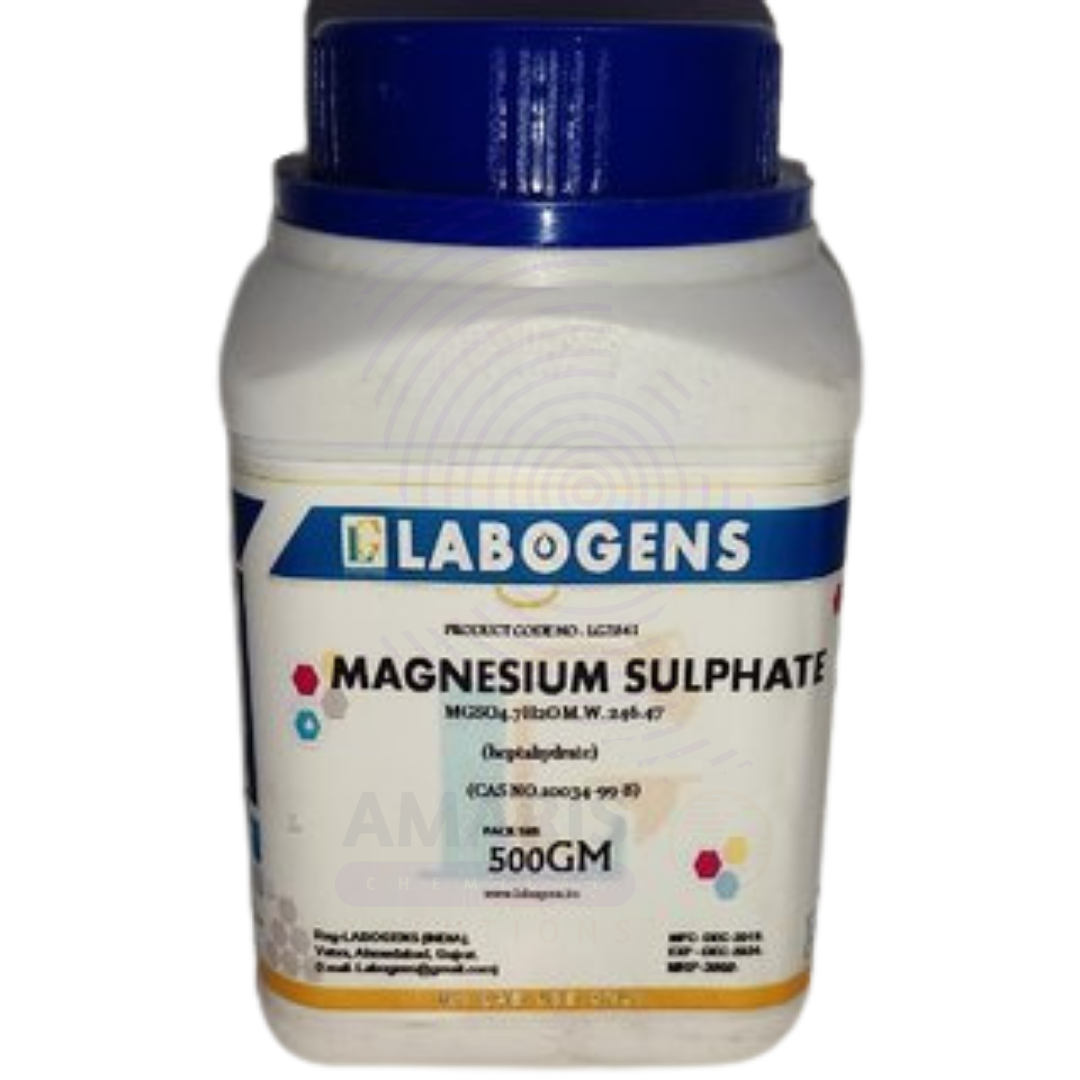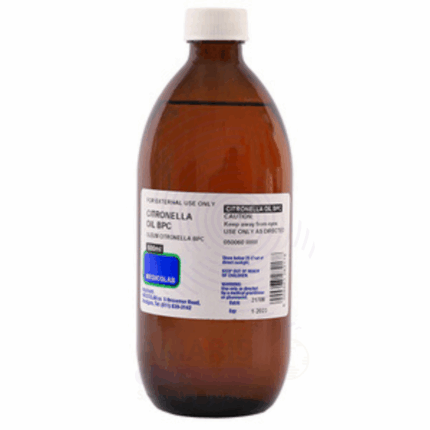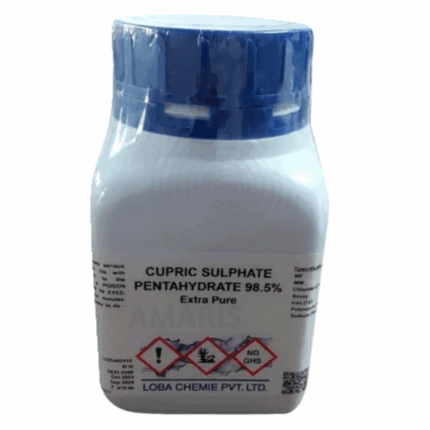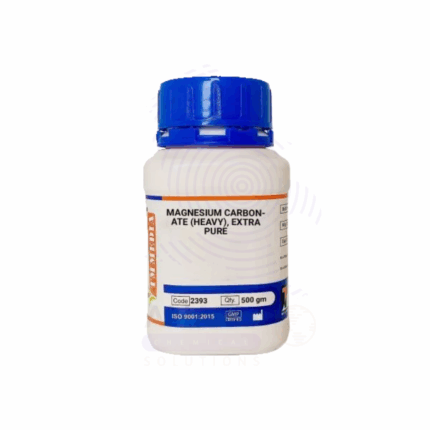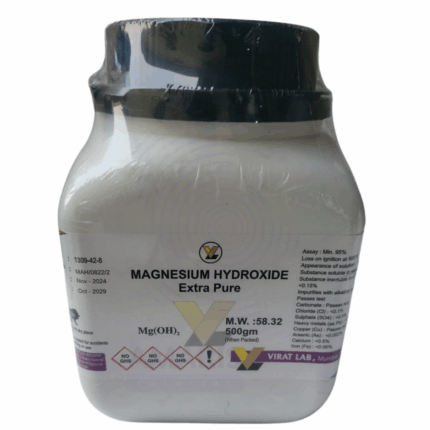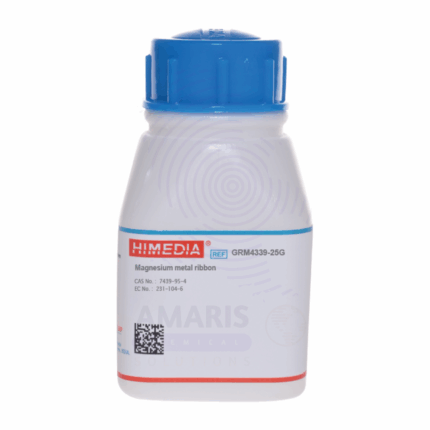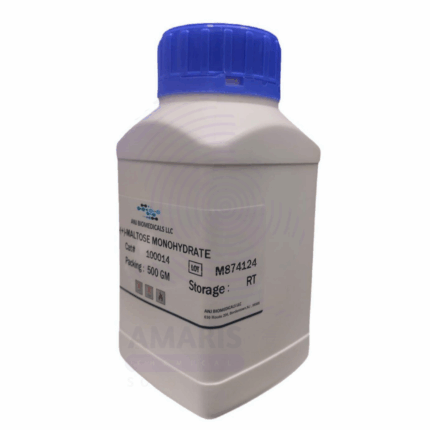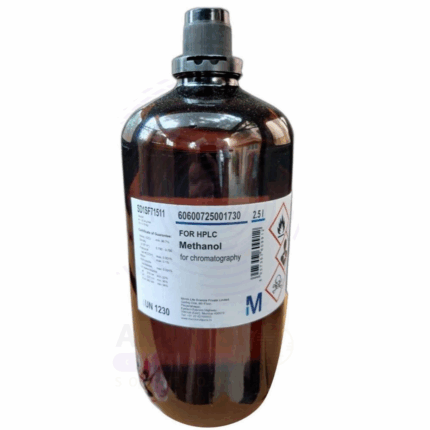
Magnesium Sulphate Extra Pure
$ 17.20
Magnesium Sulphate Extra Pure is a high-purity, inorganic compound commonly appearing as a white crystalline powder or granules. It is primarily valued in laboratories for its role as a source of magnesium ions in chemical analysis and biological experiments. This compound is widely used in buffer preparation, dehydration processes, and precipitation reactions due to its excellent solubility in water. In addition to lab applications, it also serves purposes in pharmaceutical formulations, cosmetics, and agriculture as a magnesium supplement. Its extra pure grade ensures minimal impurities, making it suitable for sensitive research and analytical tasks.
Magnesium Sulphate Extra Pure
Primary Uses
- Reagent in Analytical Chemistry:
- Used in qualitative and quantitative analysis, especially in the detection of calcium and other ions.
- Desiccant in Organic Synthesis:
- Anhydrous magnesium sulphate is commonly used as a drying agent to remove water from organic solvents.
- Preparation of Standard Solutions:
- Used in making buffer or standard solutions for laboratory tests and calibration.
Secondary Uses
- Component in Culture Media:
- Provides essential magnesium ions in microbiological and plant tissue culture media.
- Study of Osmosis and Diffusion:
- Used in biology experiments to study the effects of solute concentration on cell function.
- Educational Demonstrations:
- Employed in school experiments to demonstrate crystallization, hydration, and salt properties.
| PACK SIZE |
500 grams Plastic Tin |
|---|
1. Basic Identification Attributes
- Chemical Name: Magnesium Sulphate
- Synonyms: Epsom salt (when hydrated), Magnesium sulfate
- CAS Number: 7487-88-9 (anhydrous) / 10034-99-8 (heptahydrate)
- Molecular Formula: MgSO₄ (anhydrous) / MgSO₄·7H₂O (heptahydrate)
- Molecular Weight:
- Anhydrous: 120.37 g/mol
- Heptahydrate: 246.47 g/mol
- Appearance: White crystalline powder or granules
- Odor: Odorless
- Solubility: Soluble in water; insoluble in ethanol
- Grade: Extra Pure
- Physical Form: Powder or crystals
2. Safety & Hazard Attributes
- GHS Classification: Not classified as hazardous under normal lab use
- Hazard Statements: Not typically hazardous
- Precautionary Statements:
- P264: Wash hands thoroughly after handling
- P270: Do not eat, drink or smoke when using this product
- Personal Protective Equipment (PPE):
- Lab coat
- Protective gloves (nitrile or latex)
- Safety goggles
- First Aid Measures:
- Inhalation: Move to fresh air; seek medical attention if discomfort persists
- Skin Contact: Wash thoroughly with soap and water
- Eye Contact: Rinse with clean water for several minutes
- Ingestion: Rinse mouth; consult a physician if large amounts swallowed
- Fire Hazards:
- Not flammable
- Use extinguishing media suitable for surrounding materials
3. Storage & Handling Attributes
- Storage Conditions:
- Store in a dry, well-ventilated area
- Keep container tightly closed
- Avoid exposure to moisture (especially for anhydrous form)
- Handling Tips:
- Handle in a clean, dry environment
- Prevent contamination with incompatible materials (e.g., strong acids or alkalis)
4. Laboratory Applications
- Primary Uses:
- Reagent in analytical chemistry (especially for gravimetric analysis)
- Precipitation reactions for studying solubility rules
- Preparation of magnesium-based reagents and solutions
- Secondary Uses:
- Growth media additive in microbiology and plant tissue culture
- Osmotic stabilizer in biological and physiological experiments
- Drying agent in organic synthesis (anhydrous form)
- Demonstration of hydrated vs. anhydrous salts in teaching
SAFETY PRECAUTIONS
Personal Protective Equipment (PPE):
- Wear a lab coat, nitrile gloves, and protective goggles.
- Use a dust mask or ensure local ventilation to avoid inhaling fine particles.
Handling:
- Avoid contact with skin, eyes, and clothing.
- Prevent formation of dust and avoid inhalation.
- Wash hands thoroughly after handling.
Storage:
- Store in a cool, dry, and well-ventilated area.
- Keep the container tightly closed to avoid moisture absorption.
- Protect from incompatible substances such as strong acids or alkalis.
FIRST AID MEASURES
Inhalation:
- Move the person to fresh air.
- Seek medical attention if breathing becomes difficult or symptoms persist.
Skin Contact:
- Wash affected area with soap and water.
- Remove contaminated clothing.
- Get medical advice if irritation develops.
Eye Contact:
- Rinse cautiously with clean water for several minutes.
- Remove contact lenses if present and easy to do.
- Continue rinsing and seek medical attention if discomfort persists.
Ingestion:
- Rinse mouth with water.
- Do not induce vomiting.
- Seek medical attention if large quantities are ingested or symptoms occur.
FIRE FIGHTING MEASURES
Flammability:
- Not flammable under normal conditions.
Extinguishing Media:
- Use water spray, foam, dry chemical, or CO₂ for surrounding materials.
- No special extinguishing media required for the substance itself.
Hazardous Combustion Products:
- May emit sulfur oxides (SOx) under extreme heating or decomposition.
Firefighter Protection:
- Wear self-contained breathing apparatus (SCBA) and full protective clothing if involved in a fire.


 Preservatives(food)
Preservatives(food) Flavor Enhancers
Flavor Enhancers Acidulants
Acidulants Sweeteners
Sweeteners Antioxidants
Antioxidants Colorants(food)
Colorants(food) Nutraceutical Ingredients (food)
Nutraceutical Ingredients (food) Nutrient Supplements
Nutrient Supplements Emulsifiers
Emulsifiers
 Collectors
Collectors Dust Suppressants
Dust Suppressants Explosives and Blasting Agents
Explosives and Blasting Agents Flocculants and Coagulants
Flocculants and Coagulants Frothers
Frothers Leaching Agents
Leaching Agents pH Modifiers
pH Modifiers Precious Metal Extraction Agents
Precious Metal Extraction Agents
 Antioxidants(plastic)
Antioxidants(plastic) Colorants (Pigments, Dyes)
Colorants (Pigments, Dyes) Fillers and Reinforcements
Fillers and Reinforcements Flame Retardants
Flame Retardants Monomers
Monomers Plasticizers
Plasticizers Polymerization Initiators
Polymerization Initiators Stabilizers (UV, Heat)
Stabilizers (UV, Heat)
 Antifoaming Agents
Antifoaming Agents Chelating Agents
Chelating Agents Coagulants and Flocculants
Coagulants and Flocculants Corrosion Inhibitors
Corrosion Inhibitors Disinfectants and Biocides
Disinfectants and Biocides Oxidizing Agents
Oxidizing Agents pH Adjusters
pH Adjusters Scale Inhibitors( water)
Scale Inhibitors( water)
 Antioxidants(cosmetic)
Antioxidants(cosmetic) Emollients
Emollients Fragrances and Essential Oils
Fragrances and Essential Oils Humectants
Humectants Preservatives
Preservatives Surfactants(cosmetic)
Surfactants(cosmetic) Thickeners
Thickeners UV Filters
UV Filters
 Fertilizers
Fertilizers Soil Conditioners
Soil Conditioners Plant Growth Regulators
Plant Growth Regulators Animal Feed Additives
Animal Feed Additives Biostimulants
Biostimulants Pesticides (Herbicides, Insecticides, Fungicides)
Pesticides (Herbicides, Insecticides, Fungicides)
 Active Pharmaceutical Ingredients (APIs)
Active Pharmaceutical Ingredients (APIs) Excipients
Excipients Solvents(pharmaceutical)
Solvents(pharmaceutical) Antibiotics
Antibiotics Antiseptics and Disinfectants
Antiseptics and Disinfectants Vaccine Adjuvants
Vaccine Adjuvants Nutraceutical Ingredients (pharmaceutical)
Nutraceutical Ingredients (pharmaceutical) Analgesics & Antipyretics
Analgesics & Antipyretics
 Analytical Reagents
Analytical Reagents Solvents(lab)
Solvents(lab) Chromatography Chemicals
Chromatography Chemicals Spectroscopy Reagents
Spectroscopy Reagents microbiology-and-cell-culture-reagents
microbiology-and-cell-culture-reagents Molecular Biology Reagents
Molecular Biology Reagents Biochemical Reagents
Biochemical Reagents Inorganic and Organic Standards
Inorganic and Organic Standards Laboratory Safety Chemicals
Laboratory Safety Chemicals Specialty Laboratory Chemicals(Special Laboratory Equipment)
Specialty Laboratory Chemicals(Special Laboratory Equipment)
 Demulsifiers
Demulsifiers Hydraulic Fracturing Fluids
Hydraulic Fracturing Fluids Scale Inhibitors(oil)
Scale Inhibitors(oil) Surfactants(oil)
Surfactants(oil) Drilling Fluids
Drilling Fluids
 Dyes and Pigments
Dyes and Pigments Bleaching Agents
Bleaching Agents Softening Agents
Softening Agents Finishing Agents
Finishing Agents Antistatic Agents
Antistatic Agents
 Admixtures
Admixtures Waterproofing Agents
Waterproofing Agents Sealants and Adhesives
Sealants and Adhesives Curing Compounds
Curing Compounds Concrete Repair Chemicals
Concrete Repair Chemicals Anti-Corrosion Coatings
Anti-Corrosion Coatings
 Surfactants(cleaning)
Surfactants(cleaning) Builders
Builders Enzymes
Enzymes Solvents (Cleaning)
Solvents (Cleaning) Fragrances
Fragrances
 Electronic Chemicals
Electronic Chemicals Catalysts
Catalysts Lubricants
Lubricants Photographic Chemicals
Photographic Chemicals Refrigerants
Refrigerants Automotive chemicals
Automotive chemicals Pyrotechnic Chemicals
Pyrotechnic Chemicals
 Biodegradable Surfactants
Biodegradable Surfactants Bio-based Solvents
Bio-based Solvents Renewable Polymers
Renewable Polymers Carbon Capture Chemicals
Carbon Capture Chemicals Wastewater Treatment Chemicals
Wastewater Treatment Chemicals
 Pigments
Pigments Solvents(paint)
Solvents(paint) Specialty Coatings
Specialty Coatings Binders/Resins
Binders/Resins Additives
Additives Driers
Driers Anti-Corrosion Agents
Anti-Corrosion Agents Functional Coatings
Functional Coatings Application-Specific Coatings
Application-Specific Coatings
 Fresh Herbs
Fresh Herbs Ground Spices
Ground Spices Whole Spices
Whole Spices Spice Blends
Spice Blends Dried Herbs
Dried Herbs
 Leavening Agents
Leavening Agents Dough Conditioners
Dough Conditioners Flour Treatments
Flour Treatments Fat Replacers
Fat Replacers Decoratives
Decoratives Preservatives(baking)
Preservatives(baking)
 Plasticizers & Softeners
Plasticizers & Softeners Reinforcing Agents
Reinforcing Agents Adhesion Promoters
Adhesion Promoters Vulcanizing Agents
Vulcanizing Agents Antidegradants
Antidegradants Blowing Agents
Blowing Agents Fillers & Extenders
Fillers & Extenders Accelerators & Retarders
Accelerators & Retarders